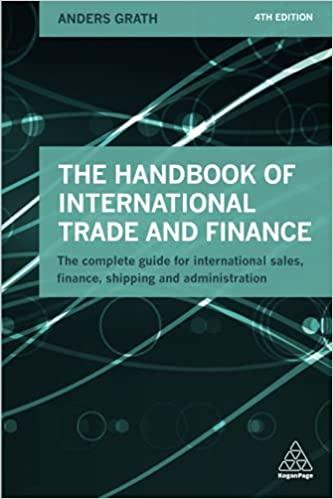Question
When we last saw the Seven Kingdoms of Westeros, a private mint owned by Tywin Lannister had produced a large number of seven-star silver coins,
When we last saw the Seven Kingdoms of Westeros, a private mint owned by Tywin Lannister had produced a large number of seven-star silver coins, called dragons, at an actual mint equivalent of 12 stars per Troy ounce, so that each star represented 1/12 ounces of silver and each dragon coin contained 7/12 ounce of silver. The mint had been defrauding the public: it had initially operated with a mint equivalent of 10 stars per Troy ounce, and it wanted the public to believe that that was still the case. Before it began the fraud, each star represented 1/10 ounce of silver and each dragon coin contained 7/10 ounce of silver. (The fraudulently-minted dragons also weighed a bit less than the originals: 7/9 ounce compared to 4/5 ounce before.)
After this debasement was discovered, the price of bread, in stars, rose from its initial level of 1/3 stars per loaf to 2/5 stars per loaf. Before the debasement, a dragon coin could buy 21 loaves of bread, because it contained 7/10 ounce of silver, and the price of bread, in monetary silver, was 1/30 ounce per loaf. [Although an ounce of raw silver would buy 27 loaves of bread, an ounce of silver contained in coins (monetary silver) would buy 30 loaves. The reason for this was the superior convenience of money in exchange.]
After the debasement was discovered, it again took 7/10 ounce of monetary silver to buy 21 loaves of bread. But that quantity of silver was now contained in 1 1/5 dragon coins, and a dragon coin now bought only 17 loaves of bread. At this point, a rebellion broke out that led to a revolution in the Seven Kingdoms. King Aerys of House Targaryen was killed and replaced by King Robert of House Baratheon, the leader of the rebellion. The new government in Kings Landing purchased all the private mints, including the Lannister mint paying generous prices and took over the coinage and monetary system of the Seven Kingdoms. Lord Petyr Baelish, commonly known as Littlefinger, was appointed Master of Coin. As the title suggests, one of the most important duties of the Master of Coin was managing the government mints. Under the new monetary system Littlefinger constructed, the basic monetary unit remained the star. But he introduced a new seven-star coin called a stag, which had an engraving of a stag (the symbol of House Baratheon) on one side. Coins produced by the government mints were made legal tender in the Seven Kingdoms. With one exception, the previous, privately minted coins were not made legal tender. The exception a concession to Tywin Lannister, who had cooperated in the rebellion was the dragon coins produced by the Lannister mint, which were made legal tender at seven stars. 2 Littlefinger ordered the government mints to begin minting stags, announcing a mint price of 11 stars per ounce and setting the mint equivalent at 15 stars per ounce. The total weight of a stag coin was the same as that of a debased dragon: 7/9 Troy ounce.
1. a. How much silver did one star represent, under the new system?
b. How much silver was there in a stag coin?
2. a. What was the fineness of the stag coins?
b. What was the debasement rate of stag coins relative to the most recently minted dragon coins?
3. a. If a merchant had traded 14 Troy ounces of silver for bread, how much bread would he have obtained?
b. 1. If this merchant had sold the 14 Troy ounces of silver to the mint, how many stars in stag coins would he have been paid? How many stag coins would he have received?
2. Assuming the price of bread had not increased (so that it was still 2/5 stars per loaf), how many loaves of bread could he have bought with these coins?
c. Was the new mint price high enough to induce merchants to bring silver to the mint? Why or why not?
4. a. Suppose a person had original (older, pre-debasement) dragon coins containing 7 ounces of silver.
1. How many coins would that have been?
2. If she had spent the old coins, how much bread could she have bought?
Note: Assume these coins traded by tale with the other legal tender coins, and continue to assume that the price of bread had not changed.)
b. Suppose a person had newer, debased dragon coins containing 7 ounces of silver.
1. How many coins would that have been?
2. If she had spent the newer, debased dragon coins, how much bread could she have bought? (Again, assume these coins trade by tale with the other legal tender coins.)
c. Would Lannister dragons of either type (original or debased) have been melted down or saved? Would dragons of either type have remained in circulation? Explain carefully.
Step by Step Solution
There are 3 Steps involved in it
Step: 1

Get Instant Access to Expert-Tailored Solutions
See step-by-step solutions with expert insights and AI powered tools for academic success
Step: 2

Step: 3

Ace Your Homework with AI
Get the answers you need in no time with our AI-driven, step-by-step assistance
Get Started


